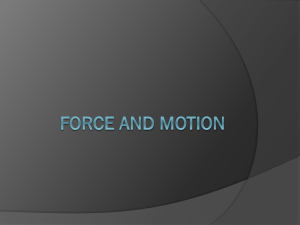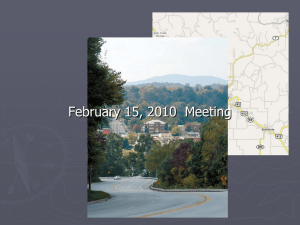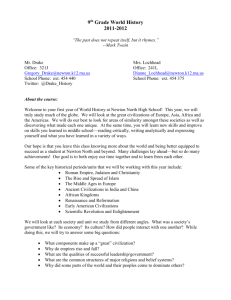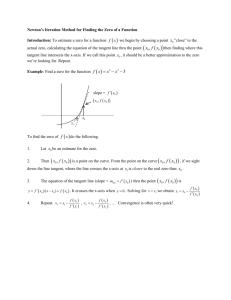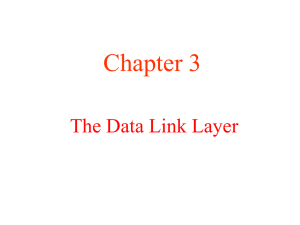Experiment on Stability: Sliding and Overturning
advertisement
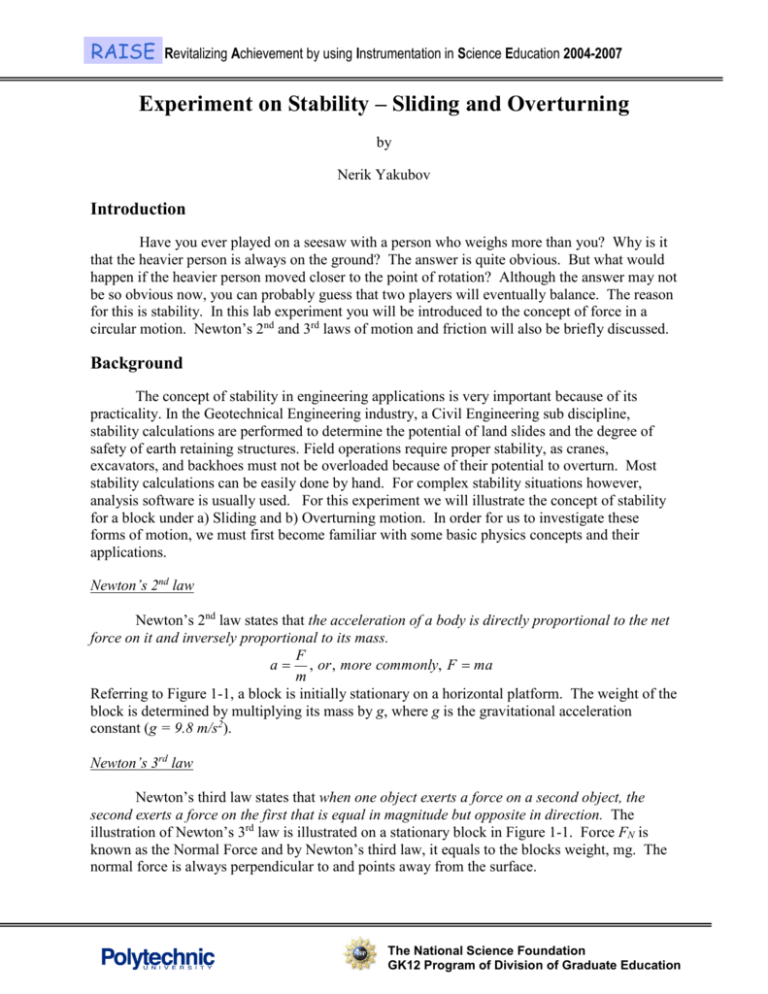
RAISE Revitalizing Achievement by using Instrumentation in Science Education 2004-2007 Experiment on Stability – Sliding and Overturning by Nerik Yakubov Introduction Have you ever played on a seesaw with a person who weighs more than you? Why is it that the heavier person is always on the ground? The answer is quite obvious. But what would happen if the heavier person moved closer to the point of rotation? Although the answer may not be so obvious now, you can probably guess that two players will eventually balance. The reason for this is stability. In this lab experiment you will be introduced to the concept of force in a circular motion. Newton’s 2nd and 3rd laws of motion and friction will also be briefly discussed. Background The concept of stability in engineering applications is very important because of its practicality. In the Geotechnical Engineering industry, a Civil Engineering sub discipline, stability calculations are performed to determine the potential of land slides and the degree of safety of earth retaining structures. Field operations require proper stability, as cranes, excavators, and backhoes must not be overloaded because of their potential to overturn. Most stability calculations can be easily done by hand. For complex stability situations however, analysis software is usually used. For this experiment we will illustrate the concept of stability for a block under a) Sliding and b) Overturning motion. In order for us to investigate these forms of motion, we must first become familiar with some basic physics concepts and their applications. Newton’s 2nd law Newton’s 2nd law states that the acceleration of a body is directly proportional to the net force on it and inversely proportional to its mass. F a , or , more commonly, F ma m Referring to Figure 1-1, a block is initially stationary on a horizontal platform. The weight of the block is determined by multiplying its mass by g, where g is the gravitational acceleration constant (g = 9.8 m/s2). Newton’s 3rd law Newton’s third law states that when one object exerts a force on a second object, the second exerts a force on the first that is equal in magnitude but opposite in direction. The illustration of Newton’s 3rd law is illustrated on a stationary block in Figure 1-1. Force FN is known as the Normal Force and by Newton’s third law, it equals to the blocks weight, mg. The normal force is always perpendicular to and points away from the surface. The National Science Foundation GK12 Program of Division of Graduate Education RAISE Revitalizing Achievement by using Instrumentation in Science Education 2004-2007 FN W=mg Figure 1-1: Newton’s 3rd law Static Friction Next, we briefly describe the law of friction. Contact friction is a force or an effect, which is created when one object is sliding against another. The frictional force is equal to the product of the normal force and the constant of static friction . The direction of the frictional force is always opposite to the direction of motion of an object. The illustration is shown below in Figure 1-2. F FN Ff = FN W=mg Figure 1-2: Free Body Diagram of Forces Sliding By now, if you understand the free body diagram in Figure 1-2, you can easily calculate the force required to slide the block along the surface. On a level platform, applying Newton’s 2nd law yields the force F is equal to FN. For sliding : F FN ; where FN mg; So, F mg. Any applied force larger than mg will overcome the frictional force and thus cause the block to accelerate. In a real life application this would mean a failure due to sliding. Overturning The National Science Foundation GK12 Program of Division of Graduate Education RAISE Revitalizing Achievement by using Instrumentation in Science Education 2004-2007 To determine when an object is overturning, we use the concept of torque or moment. Torque and moment can pretty much be used interchangeable, however most high school physics books reserve to using torque, where as in college most professors refer to it as moment. Moment is defined as a force that is applied in circular motion. The equation for moment is: M Fd ( Newton meters ); where , d is the lever arm , and F is the applied force The lever arm, d, is defined as the perpendicular distance from the axis of rotation to the line along which the force acts. Since Moment is the product of force and distance, the SI unit of moment is Newton-meters. A simple example of a moment is when we open or close a door. We apply a force on the knob but essentially we create a moment which overcomes the frictional force in the hinges and allows for the door to rotate. For the case of the wooden block as shown in Figure 1-3, around what axis will the block most likely to rotate if we apply a force on the side of the block? If you can not come up with the answer, just try pushing a four-legged stool and notice that it overturns about its far base point (back legs). What force will resist the stool to tip? If you think it’s the stool’s own weight than you are exactly correct. Similar to a force, moment is a vector quantity, meaning it has both magnitude and direction. It can be seen that the applied force is rotating the block in the clockwise direction and the weight of the block is resisting in the counterclockwise direction. As a standard convention, a clockwise rotation is considered as a negative moment and a counterclockwise rotation is a positive moment. So if we create a moment about the base point of the block, which will be greater than the resisting moment created by the blocks own weight about the same base point, then the block will begin to overturn. Figure 1-3 illustrates this concept graphically. F B/2 mg B d If Fd > mgB/2 Point of Rotation (Base Point) Point of Tipping Figure 1-3: Block Tipping Figure 1-3 shows that after the driving moment overcomes the resisting moment caused by the block’s own weight, the block begins to tip. [Note that the force must be applied high enough on the block, to form a longer lever arm, which essentially creates a stronger driving moment]. The National Science Foundation GK12 Program of Division of Graduate Education RAISE Revitalizing Achievement by using Instrumentation in Science Education 2004-2007 Objectives To gain an understanding of the two different modes of stability. To learn the concept and applications of forces in circular motion. To become familiarized with the important uses of instrumentation and technology in the real world. To learn how to function as a member of a team. Equipment List Vernier Dual Range Force Sensor Vernier Logger Pro Software w/Interface Scale Wooden Block with Hooks 4”x 6”x12” (B x L x H) Experimental Surface – Poly. University Catalog Ruler Experimental Procedure 1. Upload and run the logger pro software onto your desktop. 2. Connect the Vernier Interface to the computer via a USB port. 3. Connect the Dual Range Force Sensor to channel 1 of the interface (the software will automatically open up a plot of Force vs. Time as shown below). Figure 1-4: Vernier Software Screen 4. Using a ruler find the dimensions of the block. B =____ cm L =____cm H =____cm The National Science Foundation GK12 Program of Division of Graduate Education RAISE Revitalizing Achievement by using Instrumentation in Science Education 2004-2007 5. Using the force sensor, determine the weight of the wooden block. W =_________N 6. Change the sampling time to 15 seconds by clicking on the clock icon from the menu bar. Sliding Experiment 1. Attach the force sensor to the bottom hook on the block (Fig. 1-4). 2. Click on the button from the menu bar and slowly start pulling on the force sensor until the block starts sliding. 3. Save the data and repeat the experiment 3 more times. Record the maximum force required to slide the block in the Results section at the end of the report. Wooden Block Force Sensor Pull Experimental Surface = 0.39 Figure 1-4: Experimental Setup for Sliding Overturning Experiment 1. Attach the force sensor to the top hook on the block (Fig. 1-4). 2. Click on the button from the menu bar and slowly start pulling on the force sensor until the block starts tipping. (Note: it is important for you to pull on the force sensor slowly to get an accurate force required to tip the block) 3. Save the data and repeat the experiment 3 more times. Record the maximum force required to slide the block in the Results section at the end of the report. Force Sensor Pull Wooden Block Experimental Surface = 0.39 Figure 1-5: Experimental Setup for Overturning The National Science Foundation GK12 Program of Division of Graduate Education RAISE Revitalizing Achievement by using Instrumentation in Science Education 2004-2007 Analysis 1. Determine the experimental forces required to initiate sliding and overturning of the block from your Vernier data. 2. Calculate the theoretical forces required to slide and overturn the block and compare it with the experimental values. 3. Suppose we wanted to overturn the block before sliding it by applying a force directly to its center (same setup as in our sliding experiment). Calculate the required coefficient of static friction for that to occur. 4. On which face of the wooden block in Figure 1-6, will you have to exert the least amount of force to overturn it? Why? C A 12” 6” B 4” Fig 1-6: Problem 4 5. A ¼ inch diameter bolt was originally screwed in place with a torque of 7 Newtonmeters. Calculate the force that must be applied at the tip of a 15 cm long wrench in order to unscrew the bolt (Hint: Torque required to screw the bolt in = Torque required to screw the bolt out). 6. On a level playground, 30 kg David wanted to play on a 3-meter long seesaw with his 70 kg father. Initially, they each set on their respective edge which left David in the air and his father on the ground. David’s Father than decided to move closer to the pivot point to balance them out. How far should he move toward the pivot point for them to balance? 70 kg 30 kg x 3m Fig 1-7: Problem 5 The National Science Foundation GK12 Program of Division of Graduate Education RAISE Revitalizing Achievement by using Instrumentation in Science Education 2004-2007 References [1] [2] [3] Online: http://cosmos.colorado.edu/~urquhart/play/lever.html, web site of Playground Physics, relates playground experiences to actual physics concepts. P.W. Zitzewitz and R.F. Neff, Merrill Physics Principles and Problems, Glencoe/McGraw-Hill, Westerville, Ohio, (1995). K. Appel, J. Gasineau, C. Bakken, and D. Vernier, Physics with Computers, Vernier Software and Technology, Beaverton, Oregon, (2003). The National Science Foundation GK12 Program of Division of Graduate Education RAISE Revitalizing Achievement by using Instrumentation in Science Education 2004-2007 Results Block Dimensions and Weight Base, cm Length, cm Height, cm Weight, N Sliding Experiment Results Sheet Trial # Maximum Force 1 2 3 4 Overturning Experiment Results Sheet Trial # Maximum Force 1 2 3 4 The National Science Foundation GK12 Program of Division of Graduate Education

